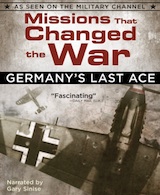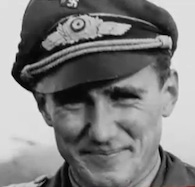 Missions That Changed the War: Germany’s Last Ace. DVD review. Athena Media. Originally broadcast on Military Channel. $49.95.
Missions That Changed the War: Germany’s Last Ace. DVD review. Athena Media. Originally broadcast on Military Channel. $49.95.
Athena Media is releasing Germany’s Last Ace, a documentary that originally aired on Military Channel’s series Missions That Changed the War. Priced at $49.95, the DVD set contains the 180-minute documentary that originally aired in four episodes, plus bonus features.
Let me say first that the content of this program is an absolute delight for anyone who is interested in the European air conflict in World War II. The opportunity to spend time with Günther Rall, the German pilot who is considered the third leading all-time “ace” of the air in an intimate, personal conversation is invaluable beyond words. Other features of the film are unique, interesting and not without a sense of dramatic tension that gives the program entertainment value.
That being said, this documentary as presented has serious structural problems that I will be pointing out, not to discourage anyone from acquiring or watching this product, but rather to act as a viewing guide so that the great content can be absorbed and enjoyed. It almost appears that this program grew out of an opportunity that writer/producer Jon Tennyson had to interview Mr. Rall. Then Tennyson rushed to put a story together to use that terrific interview material. Athena then expended little effort to turn these Military Channel episodes into a viable home entertainment product to add to their very impressive line of non-fiction offerings.
The four parts of the program cover four distinctive periods of World War II based on the development and execution of German political and military aims once the Nazis came to power—in essence a summary of the rise and fall of the Third Reich. Though Günther Rall did not come from a military family, his activities as a child growing up in the Black Forest region of Germany led him first to the Hitler Youth organization and then to joining the un-politicized military that had begun during the Weimar Republic. This was the prestigious career that Rall desired. In 1938, while preparing to be an infantry officer at the War College in Dresden, Rall requested and received a transfer to the Luftwaffe and entered flight school. He found immediate comfort in flying the plane assigned to him, the Messerschmitt Bf-109E.
When the war began on September 1, 1939, Rall was still in flight school; however Rall and his classmates were assigned to combat fighter squadron JG-52 along the German-French border. As the German blitzkrieg moved west, Rall flew the Bf-109E over France, then in the Battle of Britain. He learned how to maneuver his plane well, using its strengths and his own abilities. He began to rack up kill after kill. British fighter tactics and advanced early warning radar made the bombing of England an ineffective prelude to the planned invasion of the British Isles. The cancellation of Operation Sea Lion, the planned invasion of England by sea, meant a number of fighter units would be transferred to support the invasion of the Soviet Union; Rall, shocked that a second front was being opened, was among those sent east.
The first surprise of the film comes in the early introduction of an American flier. Hubert “Hub” Zemke was a dynamic and ambitious young man from Missoula, Montana, who left college in his senior year in 1936 for the opportunity to become an air cadet. Once he received a commission in the U. S. Army Air Corps, Zemke became an accomplished pilot and flew the P-40 Airacobra, one of the early Lend-Lease planes sent to Britain. Zemke and another USAAC pilot went to England where they had a brief opportunity to observe RAF flying tactics and formations. Before long the British, feeling that their own fighters were superior to the P-40, arranged to pass them on to the Soviet Union, in desperate need of fighters after the Germans launched Operation Barbarossa, the invasion of the USSR. Zemke and his friend went to Russia to train pilots and at times came face to face with German fighters in the fall of 1941 while the US was still neutral in the war. This fact prevented the aggressive Zemke from dogfighting with German fighters over the Russian steppe.
Günther Rall knew all about Operation Barbarossa. After a tour in the Balkans and Crete, he was assigned to the Eastern Front to support ground efforts, first from a base in Romania, and later moving through a series of temporary bases in the Ukraine. Here, he added greatly to his kill total against the underequipped and inexperience Soviet pilots. Because these dogfights occurred under 10,000 feet, no oxygen masks were used and Rall could look right into the faces of his enemies, who often became his victims. But as he points out several times in the film, the Soviet air warriors did not lack courage.
When America entered the European war, Zemke found his way back from Russia, a roundabout journey that took months. He was given command of the 56th Fighter Group, a unit he trained in Savannah, Georgia, and which was equipped with the Republic P-47 Thunderbolt, a plane Zemke did not really like. The unit was among the first American fighter groups sent to England. After a rough first few missions, the 56th began scoring kills as they flew over France in support of USAAF Eighth Air Force precision bombing. Zemke used his substantial experience and expertise to help design tactics and formations that played to the P-47s strengths. Meanwhile Günther Rall and the entire German campaign in the east were suffering through dreadful winters and strategic setbacks.
The above description reveals one of the great weaknesses of the program. The title Germany’s Last Ace is misleading: the film covers much more than the story of Günther Rall. Its strength is in presenting the parallel stories of two fliers, one Axis, one Allied, a storyline that has great development and an exciting conclusion. Unfortunately, Tennyson and his fellow filmmakers stray from this idea frequently, going off on tangents to introduce the causes of the war, explaining Lebensraum (German ethnic expansion to the east), and describing events in Italy, North Africa and other places that don’t tie in to these main characters. These other storylines are repeated often—in recaps of the previous broadcast episodes because no attempt was made to edit them out of the home entertainment version—and even within each part. Toss out the attempt to overview the entire war and the core of this program is compelling in and of itself.
 Günther Rall, an intelligent and engaging man, is relaxed and articulate while recalling his flying and wartime experience. There’s honesty in his eyes. Here’s a man who crash-landed, broke his back and was told he would never fly again—but he did. He married the doctor who helped him recover, and he and Hertha Schön spent many years together. Three times Rall met and received awards from Adolph Hitler. He shot down 275 enemy planes! A fictional story could not be any more fascinating.
Günther Rall, an intelligent and engaging man, is relaxed and articulate while recalling his flying and wartime experience. There’s honesty in his eyes. Here’s a man who crash-landed, broke his back and was told he would never fly again—but he did. He married the doctor who helped him recover, and he and Hertha Schön spent many years together. Three times Rall met and received awards from Adolph Hitler. He shot down 275 enemy planes! A fictional story could not be any more fascinating.
Rall’s American counterpart in the program, Hub Zemke, passed away before this documentary was conceived, but his story is extremely well told via proxy by his son, historian Hub Zemke Jr., and by Robert “Shorty” Rankin, another pilot in the 56th Fighter Group. In addition to being a storied air group leader, Zemke was a POW—senior Allied officer at the famous Stalag Luft I—and he later had an accomplished career in the U. S. Air Force. Rankin and Rall became fast friends during the production of the film. Whether Rankin, Zemke and Rall met in the air on March 12, 1944, while dogfighting during a large daylight bombing mission on German synthetic oil plants is the source of much discussion and screen time in the documentary.
Visually, the maps are vibrant and informative, and the program uses a number of interesting still photographs and vintage clips—some relating directly to Rall and Zemke, of course, but also some very dramatic combat clips that I’ve not seen before. Restored aircraft, particularly one elegant P-47 restoration, are also seen. As with most programs like this that try to take a huge bite out of history, repetition of images is unfortunately too frequent. One thing visually that I didn’t care for were the animated plane avatars within the on-screen talent’s title bars. They are rather distracting.
The narration by Gary Sinise, a respected actor who spends much of his off-screen time in efforts that support American military personnel and their families, is clear and effective. The music and soundtrack are very good. Captions are provided for Rall, whose English is generally understandable anyway. The entire program is close-captioned as well. Bonus features include interviews with Rall’s biographer, Dr. Kurt Braatz, and an illustrated viewer’s guide. That guide, along with the cautions expressed in this review, will help viewers get the most out of this DVD set.
(World History Group’s Aviation History magazine also interviewed Günther Rall; click on the link to read that interview.)
About the Author
Jay Wertz is the producer-director-writer of the award-winning 13-part documentary series Smithsonian’s Great Battles of the Civil War for The Learning Channel and Time-Life Video. He authored The Native American Experience and The Civil War Experience 1861-1865 and co-authored Smithsonian’s Great Battles and Battlefields of the Civil War with prominent historian Edwin C. Bearss. His most recent publications are War Stories: The Pacific, Vol. 2, The Solomons to Saipan, War Stories D-Day: the Campaign Across France and War Stories: The Pacific, Vol. I, Pearl Harbor to Guadalcanal, published by World History Group Publications.




